
35 minute read
ASK THE EXPERTS
We’ve learned a lot about resiliency the last year. What advice would you give someone to help them face an unexpected challenge with resiliency now?
Tiffany Peebles
Executive Director Parking Authority of River City, Ky. It was once said that the only thing constant in life is change. The key to success must be to stay focused and steadfast and learn how to ride the waves of change by keeping your eye on the prize and adapting when and where necessary to win the race. Don’t get stuck—keep adjusting, improvising, and moving forward.
Josh Cantor, CAPP
Director, Parking & Transportation George Mason University Life is about change but don’t lose focus of your goals, whether it’s at work or personally. Change can be scary but while I scoffed at this notion when I was younger, believing in yourself and being willing to take a chance can open more doors than you ever imagined.
Larry J. Cohen, CAPP
Executive Director Lancaster Parking Authority The COVID-19 pandemic has taught us, both financially and operationally, that we should always be prepared for a worst-case scenario. Resiliency comes from these experiences, hopefully resulting in being better prepared in our contingency, continuity, and emergency plans.
Katherine Beaty
VP of Implementation TEZ Technology Focus on understanding the triggers that cause the need to be resilient and develop a strategy to deal with it in a healthy and productive manner. Flexibility, adaptability, and perseverance can help people tap into their resilience by changing certain thoughts and behaviors—we have learned that there is no playbook for maintaining emotional health during a multitude of challenges.
Pamela E. Chikhani
General Manager SP Corporation Car Parking Management LLC The best advice I can give anyone on resilience is the faster you embrace change and act to implement it, the faster the recovery. Resisting change never resulted in any positive outcome, whether internal such as management or process change, or external such as the most recent life-changing pandemic.
/HAVE A QUESTION? Send it to editor@parking-mobility.org and watch this space for answers from the experts.
RESILIENCY I
Learning to deal with unforeseen change is all about resiliency. But how do we become more resilient?
By Ron Steedly, CAPP, MEd
LET ME START BY SAYING I LOVE MY TITLE
for this article. It reminded me of a dramatic scene in a 1973 movie involving green wafers that looked like Wheat Thins or Triscuits. Full disclosure, I was not compensated by Mondelēz International to name-drop their products.
To be sure, the world is changing at a rapid pace. I’m talking about the perfect storm of VUCA (volatile, uncertain, complex, and ambiguous) and a rapid pace. This past year with COVID-19 and its unforeseen effect on everything worldwide is an excellent example that VUCA is here to stay. Change, the VUCA way, seems to be the next normal, so we need to learn to deal with it. Did you catch that? Change is the next normal so how do we manage constant change?
Personal Experience
Please take a moment to think about a personal VUCA or other change event you made it through. Jot down what it was about and what you did to get through it. It may have been easy or hard, but you did it. Ask yourself why. The answer is probably that you wanted and were willing to put in the work. The converse is also valid—why we have not been successful. This has everything to do with our comfort zone and our willingness to push and extend its boundaries.
I remember back in the day, when the current state and future state were, for the most part, definable and the change necessary to move from the current state to the future state was doable and manageable. In my opinion, that situation rarely exists anymore. Planned change is too slow and if we do it that way, we will always be behind. We need to be agile and take action. I know it is frustrating when our current state, desired future state, and the required change in between are all on a sliding scale, but that seems to be the case more often than not.
NCY IS PEOPLE
Successful Change
According to Wikipedia:
Change management is a collective term for all approaches to prepare, support, and help individuals, teams, and organizations in making organizational change. Drivers of change may include the ongoing evolution of technology, internal reviews of processes, crisis response, customer demand changes, competitive pressure, acquisitions and mergers, and organizational restructuring.
I find it ironic that management consulting company McKinsey and Company, which developed a change management model in 1982, recognizes that 70 percent of change initiatives fail. Why is that? It is not about the model or the process. It has everything to do with the people. Our desire to resist rather than embrace change in our exponentially changing world affects us on a personal level through our physical and mental wellness. On a business/organizational level, it limits our ability to adjust, thereby affecting our desired outcomes.
We experience events when we come out on the other side better than when we started. When I say “we,” I mean as people. When we do it as people, we do it collectively as an organization. So how did we manage to come out better dealing with this change?
Change Adoption and Resiliency
Change is difficult, and our innate nature is that we do not want to change. I wrote an article awhile back for The Parking Professional that addressed adopter groups and how they respond to change. These groups are: ■ Innovators. ■ Early adopters. ■ Early majority. ■ Late majority. ■ Laggards.
We all fall into one of these depending on the change and our willingness to do it. It is important to know we have all fallen into all of these groups at one time or another. So how can you be a laggard one day and an innovator the next? Well, it depends on what it’s about and your willingness to embrace the change. It’s all about the mindset. It is all about resiliency.
We all have our working definition of resiliency. Many likely include words and phrases from these examples I pulled of the Internet: ■ The capacity to recover quickly from difficulties (Google dictionary). ■ Psychologists define resilience as the process of adapting well in the face of adversity, trauma, tragedy, threats, or significant sources of stress—such as family and relationship problems, serious health problems, or workplace and financial stressors. (apa.org).
■ Resiliency is the ability to overcome challenges of all kinds-trauma, tragedy, personal crises, plain ‘ole life problems-and bounce back stronger, wiser, and more personally powerful. It’s important because this is what we need to do when faced with life’s inevitable difficulties. (resiliency.com). ■ Resilience is the psychological quality that allows some people to be knocked down by the adversities of life and come back at least as strong as before. (psychologytoday.com).
The Aha Moment
Let me break it down for you how I did for myself when I had my aha moment: ■ My current state is excellent and I do not need an unplanned future state. ■ I have a new current state due to some unexpected change (regular or VUCA) to my current state. ■ I have an unplanned need for a future state (same as my old current state or different and better). ■ The gap between the new current state and the desired future state requires change, and change equals stress. ■ Dig deep using my “resilience” skill set to get to my new desired future state.
My aha moment was realizing resilience is required to help people deal with the unexpected and the unplanned change needs of life. If that skill set helps with the unexpected and unplanned changes, it can surely help when expected and planned.
Here’s the good news. We have all been resilient at one time or another. The skill set necessary to be resilient is in every one of us. We need to intentionally identify the traits, characteristics, skills, etc., that make one resilient and exercise them. They become muscle memory and easier to call on when we need them. We then need to decide to use those muscles more often than not.
As leaders, I challenge you to identify your resilience muscles’ current state and develop a workout plan to get stronger and resilient fit. Commit to becoming a certified resilience fitness trainer and train those in your care to be resilient fit. Our organizations can be resilient if each member is resilient before we need it. The best part is we do not need to do this alone. Take care of those in your care, and the organization will automatically be cared for by all.
Resiliency is people, so let’s tap into what is already there and succeed together. ◆

Resiliency as Innovation
RESILIENCY IS JUST ONE OF THE SKILLS parking and mobility professionals will need as the industry recovers from COVID-19 and advances forward—and it’ll be a long-term requirement for success.
Ron Steedly, CAPP, MEd, will present on resiliency as part of a panel of industry professionals during IPMI’s summer Mobility & Innovation Summit, June 29-30, online. No matter where you are or what your position is in the industry, it’s your chance to collaborate with the brightest minds in mobility, transportation, and parking. Connect with innovators, start-ups, and industry veterans as we tackle the toughest challenges and prepare you and your organization to rethink the way people get from place to place to stay ahead of demands and trends.
Topics include resiliency along with: – The Mobility Landscape and the Role of Transit and
Parking. – Pilots, Data, and Real-Life Outcomes at the Curb and in our Facilities. – Pushing the Envelope on Electric Vehicles: Planning,
Design, and Operational Impacts. – Closing the Gap: Innovation in the Mobility Space
Meets Policy & Regulatory Frameworks. – Frictionless Parking: Smoothing out the Edges for a
Seamless Mobility Experience. – Integrating Data for Effective Collaboration: APDS
Outlook and Applications for our Industry.
Members can take advantage of early-bird rates through June 7: $79 for one person and $199 for teams of up to five from the same organization. Get all the details, start writing down your questions for chat, and save your seat—click here.
RON STEEDLY, CAPP, MEd, is manager of transportation services at Texas A&M University. He’ll present on this topic during the summer IPMI Mobility & Innovation Summit, online, June 29-30, and can be reached at rsteedly@tamu.edu.
a P RIMER
Never more popular, tiny park spaces are seeing more use than ever next to the curb. Here’s everything you need to know to launch a parklet program in your operation.
By Jonathan Wicks, CAPP, and Chrissy Mancini Nichols

IF THE CURB IS THE GATEWAY TO YOUR CITY, then a parklet might be a business’s front porch. What are some design considerations for creating safe and comfortable parklets to visit with family and friends? Read on to find out what you might want to consider for your parklet program planning.
General Considerations
Parklets generally entail the conversion of one or more parallel or angled parking spaces. The number of spaces varies according to the site, context, and desired character of the installation. A parklet can serve one or multiple businesses depending on what’s desired as your city or campus allows. Safety elements at the outside corners of the parklet, such as flexible posts or bollards, alert drivers to the presence of a parklet, which may not have existed the last time they parked in this neighborhood. Wheel stops installed on either end of the parklet also serve as a buffer between parking and sitting spaces.

on parklets
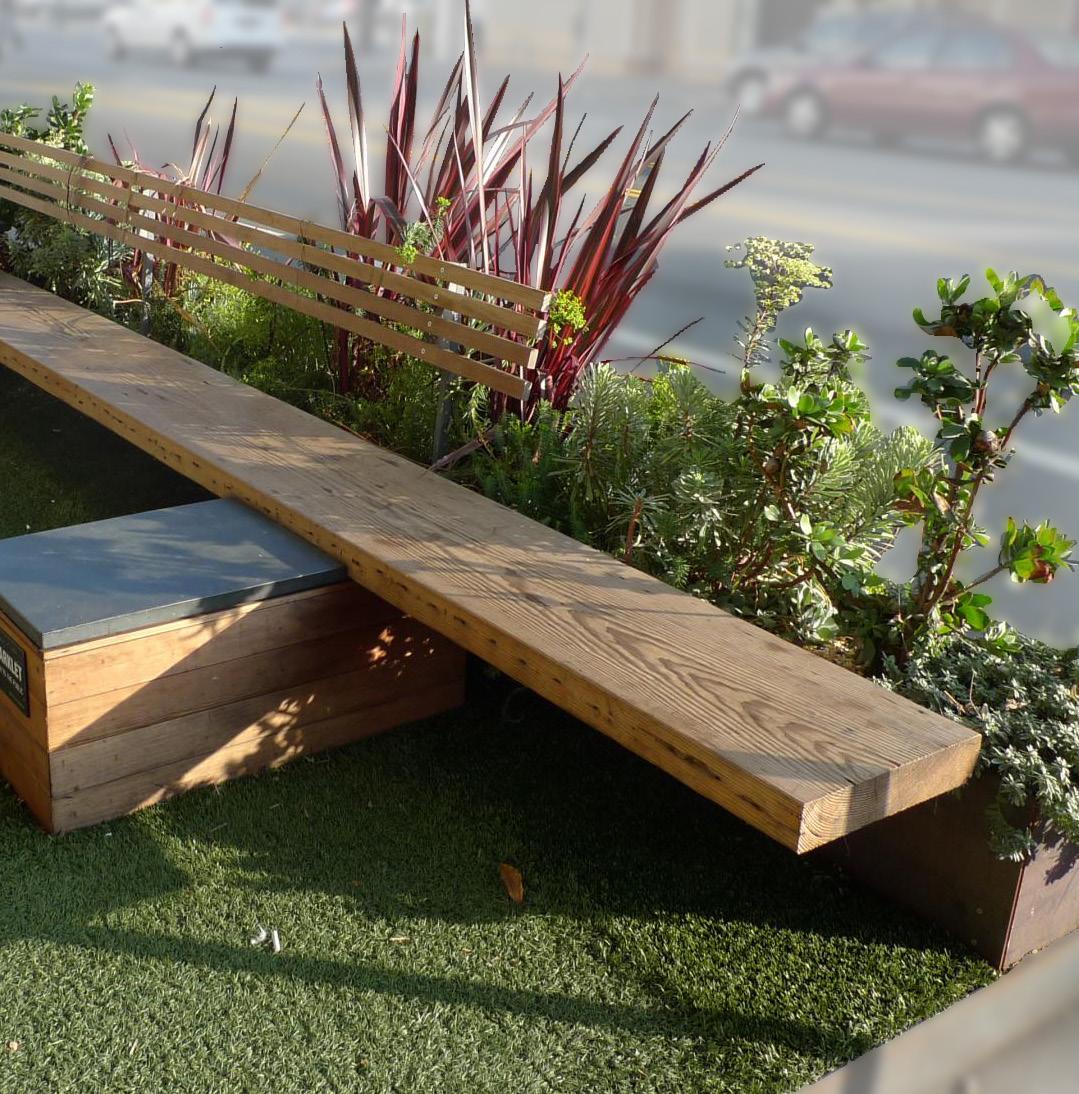


Streets maintain drainage so parklets must maintain stormwater drainage to curbs. A parklet flush with the curb (no more than 1/2-inch gap), level with the adjacent sidewalk, and accessible at several locations by pedestrians may be accessible without the addition of a ramp. Minimize horizontal and vertical gaps between the curb and the parklet surface to have a seamless connection with the existing curb to meet ADA requirements. Additional street design elements such as fire hydrants, transit stops, driveways, manholes, or public utility valves/covers will also need clearance.
Sight Line Elements
Avoid creating a buffer or obstacles in between the outside edge and railings where sightlines are needed for pedestrians to safely enter and exit the space. In no case shall any portion of the parklet, or any furniture placed upon it, obstruct the view of a traffic control device. Provide sufficient space and gaps to allow for fire department to be able to attack a fire in the adjacent buildings is critical. Check with the local fire department for requirements.
A one-foot setback from the edge of an adjacent bike lane or vehicle travel lane creates an edge to buffer the street. This edge can take the form of planters, railing, cabling, or some other appropriate buffer. The height and scale of the buffer required will vary depending on the site’s context. The parklet frame should be a freestanding structural foundation that rests on the street surface or curb. No features or structural components may be permanently attached to the street, curb, or adjacent planting strip. Parklets must
be designed for ADA compliance and shall be easily removable if/when necessary.
Single-level parklets shall only be installed on streets with a grade less than 5 percent. Multi-level parklets can handle steeper grades but will need at least one accessible entryway. In general, parklets should be placed at least one parking space from corners. The presence of a bulb-out, an on-street bicycle corral, or some other physical barrier may allow placement closer than that. Parklets shall be placed no closer than 15 feet from catch basins or fire hydrants.
The parklet design must ensure visibility to passing traffic and pedestrians and not create a visual barrier. The parklet shall maintain a visual connection to the street. The parklet should have a notable, defined edge along the side of the parklet facing the roadway and adjacent parking stalls to protect parklet users from moving traffic. This can be accomplished via a continuous railing, planter, fence, or similar structure. The height of the outside wall is dependent on the context but should be between 30 inches minimum on the street side to a maximum of 42 inches. A minimum 1-foot buffer should be maintained between the parklet features and the travel lane to increase safety adjacent to moving traffic.
Parklets in Loading Zones or Short-term Spaces
If you are considering putting a parklet or streatery in a loading zone or other specialty designated space, it is recommended you first look for a nearby location to move that zone and then notify other businesses on the block of your desire to do so. Consideration can be given to removing the special zone with acknowledgment from the impacted block’s other property managers, owners, street-level businesses, and/or residential property associations. There may be a public hearing requirement in some jurisdictions for the removal of special zones.
Parklet Amenities
Seating
All parklets are encouraged to provide built-in seating, which can be integrated in a variety of creative ways. These seats can be a part of the structure, planters, or creative features within the parklet. Comfortable places to sit are important to creating welcoming and inviting public spaces. Additional movable seating is recommended as well. This seating can be removed and stored at the end of the day or locked with cables to the parklet structure.
Landscaping
Your parklet should consider some type of landscaping. Landscape plantings help soften the space and can serve as a pleasant buffer along the street-facing edge. Landscape elements may be incorporated as planter boxes, hanging planters, green walls, raised beds, or similar features. Drought-tolerant and native plants are good choices for ease of maintenance. Edible plants and plants with fragrance, texture, and seasonal interest are also recommended.
Signs
Jurisdictions should consider requiring signage indicating the space is public. In the case of streateries, the sign must explain the hours when the streatery is for the use of the adjacent business and when it’s available to the general public. These signs should be mounted to both ends of the parklet and should be
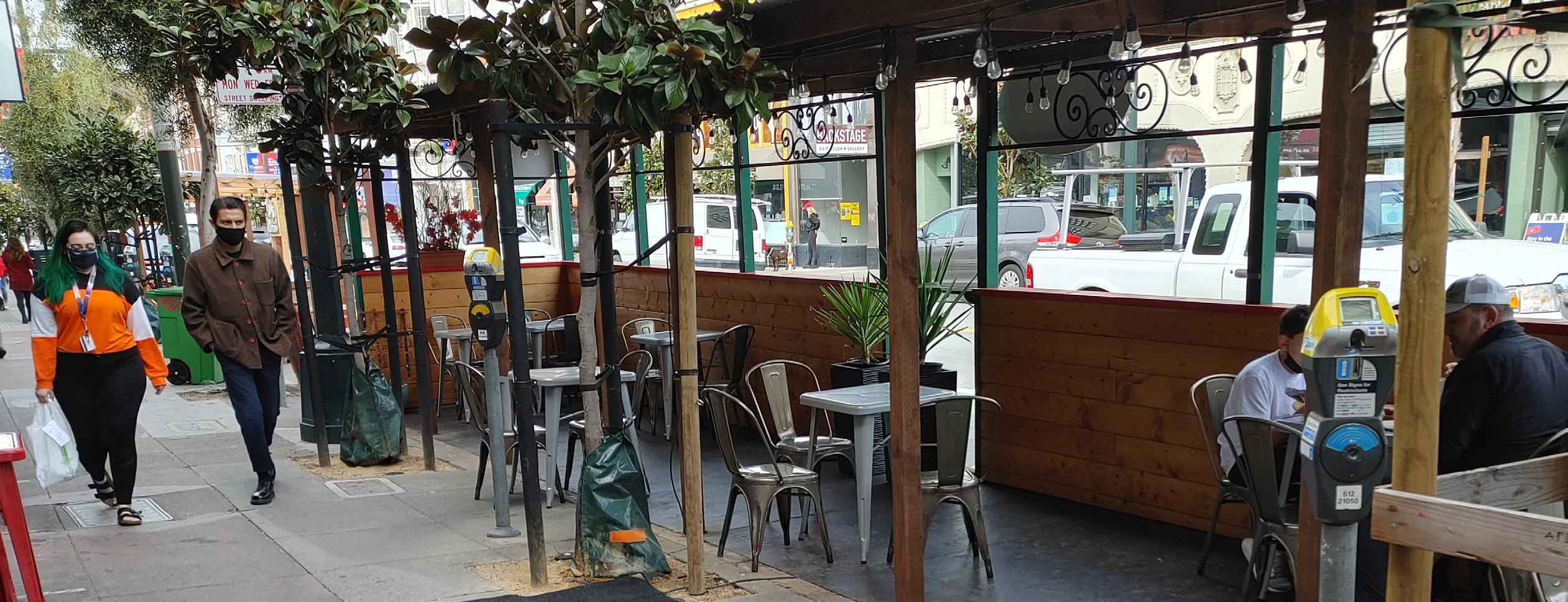
visible from the adjacent sidewalk. Signs acknowledging sponsorship, logos, or designs that “brand” the parklet must comply with local codes or regulations.
Heating and Gas Power
Outdoor heaters and elements that use gas or propane fuel can help to make your parklet more comfortable throughout the year. Heating and gas-powered features are allowed in parklets/ streateries but will require an additional permit.
Lighting
Lighting is allowed but may require a permit, depending on what you propose. Self-contained low-voltage systems, such as solar or battery-powered lights, are a good choice. Decorative or seasonal lighting may be allowed in street trees near the parklet.
Plan Submittal Elements
Plans should include sufficient detail as to allow for adequate review. Consider including these items on plan submittals and permit applications: ■ Location on the street. ■ Street and sidewalk utilities (i.e., manholes, water valves, etc.). ■ Street poles and signs. ■ Fire hydrants and Fire Department connections on adjacent buildings. ■ Street furniture (litter cans, benches, etc.). ■ Street trees, including tree surrounds. ■ Sidewalk and street grade elevations. ■ Parklet dimensions. ■ Parklet materials and details as necessary. ■ Parklet planting plan. ■ Flexible delineator posts and wheel stops. ■ Material, design elements, or other proposed features.
Learn more about parklets, including design and other considerations, in an IPMI Education Development Committee video here. ◆
JONATHAN WICKS, CAPP, is a project manager with Walker Consultants. He can be reached at jwicks@ walkerconsultants.com.
CHRISSY MANCINI NICHOLS is lead, curb management and mobility, with Walker Consultants. She can be reached at cmancini@walkerconsultants.com.
Unparalleled data mining down to the bay level. Maximized ops control with data-driven insights. Elevating CX through intelligent infrastructure.
The innovation hub for next-generation parking.
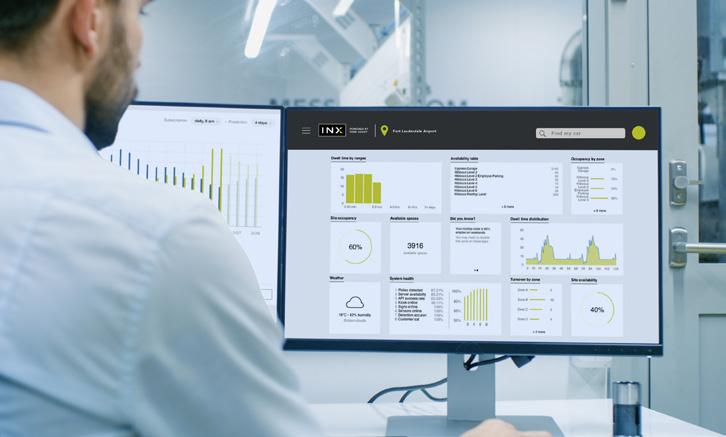
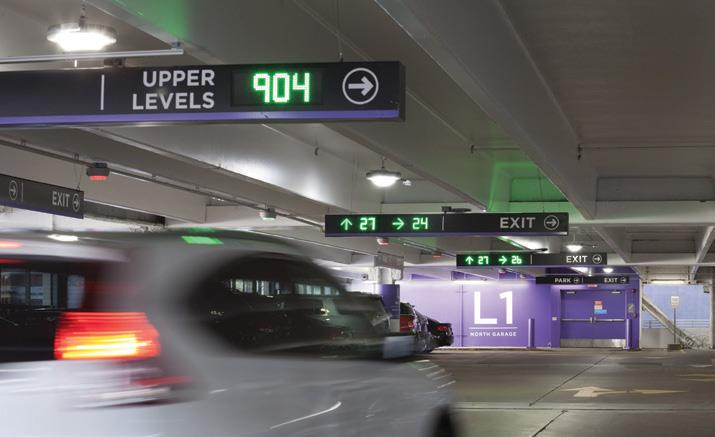

Our pioneering smart-sensing parking guidance system (PGS) continues to anticipate the future with additional beyond-guidance technologies. Already proven in hundreds of successful installations worldwide, it’s the only PGS to seriously consider. Find out why. +1 203-220-6544 parkassist.com
The Case for Exclus
By Jim Corbett, CAPP and John Dorsett, AICP
CITIES should increasingly consider whether now is the time to switch from an on-street parking program that features metered parking or a combination of metered parking and pay-by-cell phone to a program that requires all parking payments be made by cell phone. Cities can save significant expense including capital and maintenance costs and the costs to collect and account for coinage, plus avoid shrinkage from compromised revenue controls.
Capital costs to meter an on-street parking space typically range from $800 to $1,200 for the meter, pole and housing or kiosk, signage, and installation. Depending on the size of the system, significant dollars spent on operating expenses could be saved. This is relevant in a time where parking volumes
Excluslve Pay-by-Cell
By Jim Corbett, CAPP and John Dorsett, AICP
and subsequent revenues are down, and cities are scrambling to balance operating budgets.
Pay-by-cell provides a higher level of customer service than parking meters. Visitors do not have to fumble for coins. Pay-by-cell allows contactless payment, a desirable feature during a pandemic. Time can be added to the parking session remotely and without a visit to the parking space. Payment can be made from the comfort and security of one’s personal vehicle as opposed to standing on the street.
There are several arguments for not making the change, but these arguments are diminishing with time and may no longer be valid reasons for cities to not take the plunge and enjoy the cost savings and improved customer service levels that pay-by-cell phone offers. Concerns include the fact that pay-bycell can be a frustrating experience for the “technology-challenged” among us and also requires that one have a cell phone. The following counterarguments are offered to those who may advocate for the status quo: ■ Cell phone ownership and smartphone usage are at all-time highs and ownership differences by income cohort and ethnic groups are immaterial. ■ While a small percentage of people are unable to secure the credit required for a cellular phone,
many of these same people are also not car owners and therefore do not need a parking space; also, in larger cities, car ownership ratios are lower. ■ An even smaller percentage of this demographic are patronizing commercial business districts that require payment for parking. ■ If payment by cell phone is not possible, visitors can find plenty of available parking off street, and typically at a lower cost, or they can perhaps buy a gift card at a local drug store that would allow them to pay for parking by card. ■ Of those 49 years of age or younger, 92-99 percent1 own smartphones—a large percentage of the 8 percent who do not own smartphones are not likely to do business in an urbanized commercial district and park on street or they are not likely to own a car. ■ If you don’t have a smartphone, how likely is it that you are going to be someone who patronizes a business in an urbanized commercial district and must park on street? ■ Pay by phone has been around for two decades and is well established. The three primary U.S. pay-by-cell phone providers of ParkMobile, Passport, and PayByPhone reported that they have installations in an estimated 1,000 U.S. cities. ■ City administrators and elected officials owe it to tax-paying constituents to exercise financial prudence and not unreasonably spend unnecessarily to benefit a very small minority, especially when other options exist.
Pay-by-cell phone has been proven to be effective and the arguments for parking meters and against exclusive pay-by-cell phone are dwindling. This discussion explains why and how this shift is occurring.
What Is Pay-by-cell Phone and How Does It Work?
Mobile payments have been around for two decades and are a proven and widespread payment method. In 2000, a patent for mobile payment technology was granted in the U.S.,2 enabling a motorist to pay for parking charges using a mobile network provider and mobile payment application. Most pay-by-cell phone solutions require pre-registration, including the need to provide either a credit card for parking charges or the use of a credit card to pre-load a prepaid account. Typical information required upon registration includes data such as the mobile phone number(s) that the motorist wishes to use to initiate the parking session, license plate information of the vehicle(s) that the motorist wishes to utilize and credit card information.
To activate a parking session, the motorist must first arrive at a designated pay-by-cell phone parking area. For the service to be available, the operator of the parking space, whether a city or a private owner, must have contracted with the pay-by-cell phone service provider. If the service is available it will be clearly marked on the street, meter, sign or space. Then the motorist can either call the pay-by-cell phone service provider (via a tollfree number) or use their mobile application.
The motorist must identify their parking zone or parking space number and communicate this information to the pay-bycell phone provider via phone operator or mobile application. When calling the pay-by-cell phone operator, the motorist will be guided through the registration process to include communicating vehicle and credit card information. Once completed, the motorist’s mobile phone number will then be associated with the account for future parking sessions. Prior to activating the parking session, an opportunity to confirm the duration of stay, applicable charges, and correct vehicle license plate information will ensue before the motorist completes the transaction.
Mobile text reminders may be programmed to notify the motorist when their parking session is about to expire. In the event a motorist needs more parking time, an option to extend the parking session may be executed with parking systems that support this option. Extended parking sessions may be initiated using the prevailing rate structure.
Prevalence of On-Street Parking Pay-by-cell Phone
Fifty U.S. state capital cities were surveyed to identify the presence of on-street parking payment by cellular phone. This sample data set represents a wide variety of U.S. cities including some large cities with large footprints and dense vertical downtown urban environments such as Atlanta, Denver, Nashville,
100
90
80
70
60
50
40
30
20
Figure 1: Percentage of U.S Adults Who Own a Cell Phone Versus a Smartphone
Cellphone
Smartphone
10
0
2004 2006 2008 2010 2012 2014 2016 2018
SOURCE: PEW RESEARCH CENTER; SURVEYS CONDUCTED 2002-2019
Category Total Table 1: Percentage of U.S. Adults Who Own the Following Devices
Any cellphone Smartphone
Cellphone, but not smartphone
96% 81% 15%
Men
98% 84% 14%
Women
95% 79% 16%
Ages 18–29 Ages 30–49 Ages 50–64 Ages 65+ White Black Hispanic Less than high school graduate High school graduate Some college College graduate Less than $30,000 $30,000–$49,000 $50,000–$74,000 $75,000 Urban Suburban
99% 96% 99% 92%
4% 6% 95% 79% 17% 91% 53% 39% 96% 82% 14% 98% 80% 17% 96% 79% 17%
92% 66% 25%
96% 72% 24% 96% 85% 11% 98% 91% 7% 95% 71% 23% 96% 78% 18% 98% 90% 8%
100% 95%
5% 97% 83% 13% 96% 83% 13%
Rural
95% 71% 24% and others with small footprints and two- to three-story buildings such as Cheyenne, Pierre, and Helena.
The results of the survey revealed that 7 of the 50 cities do not charge for on-street parking. Of the 43 cities that do charge for on-street parking, 33 offer on-street parking payment via cellular phone app. One city does not yet but is in the process of introducing the service. With this additional city, 79 percent of the capital cities that charge for on-street parking, offer payment by cellular phone.
Factors and Considerations for On-Street Pay-by-Cell Phone Exclusivity
The vast majority of Americans—96 percent—now own a cell phone of some kind. The share of Americans that own smartphones, a form of a cell phone, is now 81 percent, up from just 35 percent in Pew Research Center’s first 2011 survey of smartphone ownership. Along with mobile phones, U.S. citizens own a range of other information devices. For example, nearly three-quarters of U.S. adults now own desktop or laptop computers, while roughly half now own tablet computers and roughly half own e-reader devices.3
Mobile payments continue to trend in the U.S. smartphone market, as the penetration of smartphone payment services is projected to reach more than 30 percent of U.S. smartphone users.4
Smartphone ownership is immaterially lower for lower income groups and the 65+ age group. While the U.S. numbers continue to grow across age groups, persons of the 65+ age group are most likely not to have access to a smartphone.
Arguments for Pay-by-Cell Exclusively
■ Cost savings to city—no parking meters needed; no cash collections, no coin jams or malfunctioning meters, no meter maintenance or repairs, and no ongoing SaaS (Software as a Service) subscription services. ■ Staff may be repurposed for other essential city service needs. ■ More efficient cash controls with the removal of manual cash handling. ■ Enhanced public safety of motorist initiating their transaction in a secured and sheltered environment of their personal vehicle. ■ Reduced liability in the form of less coins collected and temporarily housed in on-street meters. ■ Motorist ease of adding time to their parking session while away from their parked vehicle. ■ Inability to piggyback on prepaid time when using single-space meters. ■ Eliminates motorist frustration with the requirement to carry coins to pay for parking. ■ Allows for the reservation of parking sessions in many paid parking environments.
Arguments Against Pay-by-Cell Exclusively
■ Requires motorist to use cell phone; and may be difficult for some who are technology-challenged. ■ Fear of sharing and storing personal data with a third-party app provider; and fear of identity theft. ■ A percentage of the general population do not have the ability to place a credit card account on file with the mobile application provider for payment privileges.
Systematic Approach to Successful Implementation of Pay-By-Phone Exclusivity
A successful implementation of a pay-by-cell program requires the consumer’s willingness to adopt this method of payment for parking transactions. In recent years we have seen many communities implement a pay-by-cell solution as an alternative payment method to single and multi-space meter payment options. In a few instances, municipalities have made the operational leap from a single-space, coin-only parking meter, to the addition of a pay-by-cell solution. Usually, this implementation comes as a result of a neighboring municipality’s successful implementation and adoption, creating political pressure for other municipal agencies to follow. We find this common approach instrumental in our short list of recommendations for a successful implementation of an exclusive pay-by-cell program.
Attrition Approach As the operation and utilization of multi-space meters decline throughout certain areas of downtowns, consider downsizing physical parking meter assets and repurposing inventory to push motorists to use the pay-by-cell option versus the meter option. Requiring a behavioral change, motorists may be willing to use the pay-by-cell option if it means they do not have to walk out of the way to find the next available parking kiosk.
Destination District Approach Frequent and popular destination districts, otherwise known as entertainment and recreation districts, will often provide an opportunity to introduce new technology solutions. Users of these districts generally want quick and easy access to parking options to allow more immediate access to enjoying the amenities the district has to offer. The absence of parking kiosks and single-space meters will most likely enhance the look and feel of the pedestrian pathways within the district.
On-Street Program Expansion Approach Procurement of additional meters to expand an on-street parking program typically requires a capital funding plan with a justified return on investment analysis. Expanding an on-street program with a pay-by-cell only strategy substantially reduces the capital funding to the simple cost of adding an instructional sign package and promotional advertisement. Implementation of this type of program expansion may also occur in much shorter time frame.
Parking Benefit District Approach Parking Benefit Districts are designed to charge a fee for a motorist to park on street only to have the proceeds from their parking transaction used to make various infrastructure improvements such as street sweeping, tree planting and trimming, sidewalk and street repair, street lighting, graffiti removal, historic preservation, or simply putting overhead utility wires underground. Use of a pay-by-cell only program contributes to the unique branding efforts of the district and allows the revenues to be electronically tracked, appropriated and spent using a secure tracking environment, free from cash handling discrepancies and mishaps.
Arena and Performing Arts Center District Approach Typically, these types of districts allow an opportunity for motorists and event attendees to receive the benefit of promotional advertising and venue discounts with their payment transaction. Motorists completing a pay-by-cell parking transaction may be eligible to receive a venue discount for food and beverage or team and gift shop purchases when paying to park during pre-event hours.
Transit Corridor Approach Municipal streets providing heavy transit use may consider the need to incorporate a pay-by-cell only program to reduce rightof-way obstruction and prevent the ability for motorists to pay for parking during restricted hours. Integrating a pay-by-cell solution with this business rule may also be tied to a pay-by-cell parking guidance solution to inform the motorist when a parking space is available for use. ◆
JIM CORBETT, CAPP, is director of studies for Walker Consultants. He can be reached at jcorbett@ walkerconsultants.com.
JOHN DORSETT, AICP, is senior vide president for Walker Consultants. He can be reached at jdorsett@ walkerconsultants.com.
REFERENCES
1. https://www.google.com/amp/s/9to5mac.com/2018/09/30/pew-data-smartphoneownership/amp/ 2. https://patents.google.com/patent/US20020073027A1/en 3. https://www.pewresearch.org/internet/fact-sheet/mobile/ 4. https://www.statista.com/topics/2711/ us-smartphone-market/#dossierSummary__chapter1
INNOVATION,COLLABORATION, AND A BRIGHT FUTURE

OPINION By Elizabeth Zealand, Mark Frumar, and Michelle McDonald INNOVATION,COLLABORATION, BRIGHT FUTURE Why thinking like a startup is more important than ever.
—ALBERT EINSTEIN
ADRIVE-THROUGH OPERA performance in a parking garage in Chicago? Safe curbside food pickups from your favorite restaurant? Repurposed parking lots into pop-up kitchens supporting local restaurants and delivery services? Huge surges in contactless payment options? New digitized curbsides and mapping technology? It is clear to see how innovative and adaptive thinkers are revolutionizing the parking and mobility space. This way of thinking goes hand in hand with why thinking like a startup is so important.
Several years ago, one of this article’s authors (Elizabeth) was fortunate to grow a career working in the state and federal government in Australia. This meant driving large-scale mobility and transportation initiatives in the customer experience space, to improve a more seamless journey for millions of daily commuters in the Greater Sydney region.
It wasn’t until 2016, after seeing a gap in the market for the need to digitize curbsides, parking garages, lots, and university campuses that she decided to trade the corporate life and founded a startup, Spot Parking. Being one of a scarce number of CEOs who doesn’t own a car yet runs a technology parking company translates into never a dull moment working in this ever-changing industry. During the past 5 years, she has seen firsthand the benefits of being agile, innovative, and swift moving to work on collaboration projects with organizations.
Let’s unpack this some more: why is thinking like a startup is so important?
Here are some key reflections and observations after moving from working in government to startups. ■ Experiments can reduce, not increase risk. ■ Get out of the building. ■ Move faster. ■ Create proof-of-value opportunities. ■ Procure for outcome not process.
The Philosophy of a Startup
The philosophy of a startup is to test things before they are ready with customers, a view which often does not sit well with government risk appetites, but can often be managed successfully through targeted communication and test groups. The greatest value to a startup is having the product tested in a live environment and seeing if we are solving the problems we think we are.
Many cities and universities don’t realize the unique opportunities of partnering with a startup or emerging technologies. Beyond the benefits of working in an agile and often breakthrough way, there are many private and government incentives to support cities and universities to partner with emerging tech, including grants, live labs and smart city alliance projects.
It is important to note that procurement documents and specifications are often written in isolation of emerging technology and are out of date by the time the tender is written. While pilots are a great way to experiment, it’s important to consider: What happens if this goes really well? What is the future path forward that doesn’t stop the momentum?
One barrier to effective engagement with startups is the decision-making time cycle and the lack of emerging industry consultation. Cities and universities that are most successful are proactive with tech communities, startups, incubators and smart city communities and get out of the building, actually using their own products and services and learning from these experiences. Elizabeth experienced the get-out-of-the-building phenomenon rolling out a Sydney-wide transport ticketing system cutover. After endless assurances that the technology was in place and working, she traveled around on the rail network using it herself—only to find several glitches not previously surfaced!
It is surprising how often people don’t use their own technology as a customer, or even try and find information from their own websites. Don’t leave it to the technologists or product managers to improve your product—walk through your business in the customers’ shoes regularly.
Create Proof of Value Opportunities
Innovation challenges and projects can hold immense value if they are constructed to be leveraged for multiple use (such as smart cities, health and university campuses, airports and the like), and include open-data applications and learnings to inform larger procurements.
It is important for large, established companies providing transportation services to look at collaboration with startups to add value to their existing contracts, as they often don’t have a team size (or the current capacity) to conduct specific and unique projects. Rather, a more viable option is to outsource and drive a project with startups, as these small to medium-sized enterprises can deliver key parts of projects much quicker re: the speed of execution.
For many, now is the time to engage in these types of initiatives. The U.S. is in a unique limbo state, not quite open entirely, yet bracing for new changes in driver habits, mobility, and parking demands.
Procurement strategies that drive collaboration with startups include: ■ Innovation KPIs in existing contracts. ■ Live labs & hackathons. ■ Innovation proposals. ■ Unsolicited proposals. ■ Be the willing customer for tech vouchers, MVP, grants, test beds, pilots. ■ Industry collaboration—can the “usual suspects” partner with new and different resources. ■ Shared infrastructure—within and without cities and universities.
As they say, you don’t know what you don’t know and you won’t always find the best solution through traditional procurement. A fresh perspective through the lens of a startup could be exactly what you’re looking for.
Pillars
In the past 12 months, we have seen numerous developments within the industry of parking and mobility. Change is occurring rapidly due to technological developments, a growing demand for sustainability and the pressing need for flexibility. The future of parking and mobility not only promises of innovations that will ease the ordeal of parking for the user, but also promises a bright future of possibilities to thrive for the parking provider.
Three emerging pillars for parking and mobility:
Frictionless—contactless, end-to-end solutions where parking spaces can be pre-planned and pre-booked, with driver guidance to the space, and paid for digitally.
Sustainable—increase in curb usage for mobility-as-a-service (MaaS) strategies to reduce single private vehicle use, and use of parking as a carrot for EV usage and rideshare.
Connected—integration of different technologies through IoT for better prediction, analytics, and real time-data.
In a perfect world, digital infrastructure will allow anybody to search, find, understand, and pay for curbside use directly from our car, phone, or wearable device.
Through key data-first insights parking providers can better model capacity and utilization. Such capabilities can be extended to allow cities and traffic planners to better shape their curbside assets. Ride-hail, rice-share, carpool, and autonomous shuttles (COVID notwithstanding) will need priority curbside space to operate effective first- and last-mile solutions. The ability to change curbside rules rapidly and communicate them to the public using digital infrastructure will be crucial to MaaS initiatives. For example, during events drop off-only zones can be created where paid street parking typically exists.
Green initiatives will continue in the parking industry from environmentally friendly power sources and green building material to the overall push to reduce emissions.
COVID-19 showed a rethink of curb use. On- and off-street parking spaces became COVID drive-through testing centers, outdoor dining areas, storage facilities, pickup and dropoff zones, community performance spaces, and mobility zones. Curbside assets are too valuable to simply be used for single, private-use parking, and asset owners need to be more innovative in their thinking around asset utilization.
In this rapidly changing world, all industries have been affected by innovation and evolving consumer demands. It has never been as important to ensure that your operations stay current in this market place.
The journey’s end is a great place to start.
“There can be no life without change, and to be afraid of what is different or unfamiliar is to be afraid of life.” —Theodore Roosevelt. ◆
ELIZABETH ZEALAND is CEO and founder at Spot Parking. She can be reached at elizabeth@spotparking.us.
MARK FRUMAR is general manager, North America for Spot Parking. He can be reached at mark@ spotparking.us.
MICHELLE MCDONALD is business development lead for Spot Parking. She can be reached at michelle@ spotparking.us.
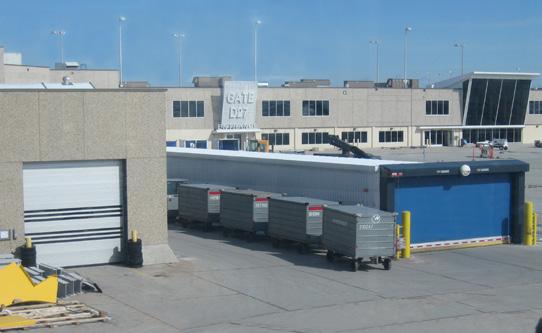
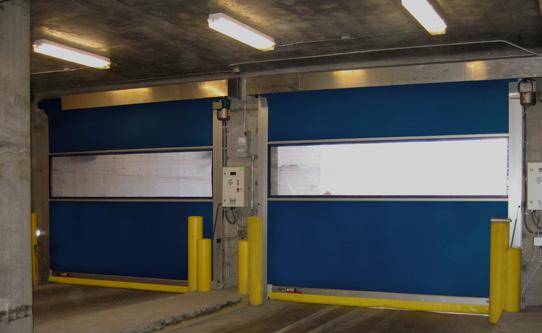


This month’s numbers:

Data and graphs provided by Smarking
by the Numbers
As the parking and mobility industry recovers, Parking & Mobility will publish the latest regional parking statistics in every other issue.
0
% Change 2021 vs 2020
-20
-40
-60 North America On-Street Garages YoY Demand
1/4 1/11 1/18 1/25 2/1 2/8 2/15 2/22 3/1 3/8
Week of
0
% Change 2021 vs 2020
-20
-40
-60
-80 West Region Off-Street Garages YoY Demand
1/4 1/11 1/18 1/25 2/1 2/8 2/15 2/22 3/1 3/8
Week of
0
% Change 2021 vs 2020
-20
-40
-60 North America Off-Street Garages YoY Demand
1/4 1/11 1/18 1/25 2/1 2/8 2/15 2/22 3/1 3/8
Week of
0
% Change 2021 vs 2020
-20
-40
-60
-80 Southwest Off-Street Garages YoY Demand
1/4 1/11 1/18 1/25 2/1 2/8 2/15 2/22 3/1 3/8
Week of
0
% Change 2021 vs 2020
-20
-40
-60 Midwest Off-Street Garages YoY Demand
1/4 1/11 1/18 1/25 2/1 2/8 2/15 2/22 3/1 3/8
Week of
0
% Change 2021 vs 2020
-20
-40
-60 Northeast Off-Street Garages YoY Demand
1/4 1/11 1/18 1/25 2/1 2/8 2/15 2/22 3/1 3/8
Week of
Sample Sizes: North America—540+, West—200+, Southwest—240+, Midwest—60+, Northeast—90+







